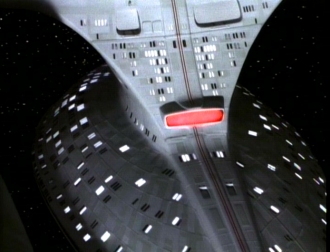
In Star Trek, starships use their impulse propulsion system for sub-light speed travel while in orbit or travelling within a solar system (as opposed to using faster-than-light warp propulsion for interstellar travel). The impulse drive is powered by a series of fusion reactors are fueled by deuterium. A set of high-powered magnetic accelerator coils drives the reactor exhaust through a set of sub-space field coils which can propel the ship at up to 0.999 of light speed. Normal maximum impulse speed is about one-quarter the speed of light - though this may seem slow in inter-stellar terms, note that this is over 167 million miles per hour.

Basically, fusion-powered spacecraft are designed to recreate the same types of high-temperature reactions that occur in the core of the sun. A fusion reaction occurs when two atoms of hydrogen collide to create a larger helium-4 atom, which releases energy. The enormous energy created from those reactions is expelled from the engine to provide thrust. While fusion drives are not yet in use today, NASA is looking at a number of fusion propulsion projects. One such projecy is Variable Specific Impulse Magnetoplasma Rocket (VASIMIR). This is actually a plasma rocket, which is a precursor to fusion propulsion. It creates plasma (partially ionized gas) under extremely hot conditions and then expels that plasma to provide thrust.
Being developed simultaneously with VASIMR is the Gas Dynamic Mirror (GDM) Fusion Propulsion system. In this engine, a long, slender, current-carrying coil of wire that acts like a magnet surrounds a vacuum chamber that contains plasma. The plasma is trapped within the magnetic fields created in the central section of the system. This plasma is ejected to provide the required thrust, with mirror magnets at each end of the engine are to prevent too much the plasma from escaping out the ends of the engine too quickly.
While many of NASA's advanced propulsion concepts are decades from being achieved, the foundation of fusion propulsion is already being built.
